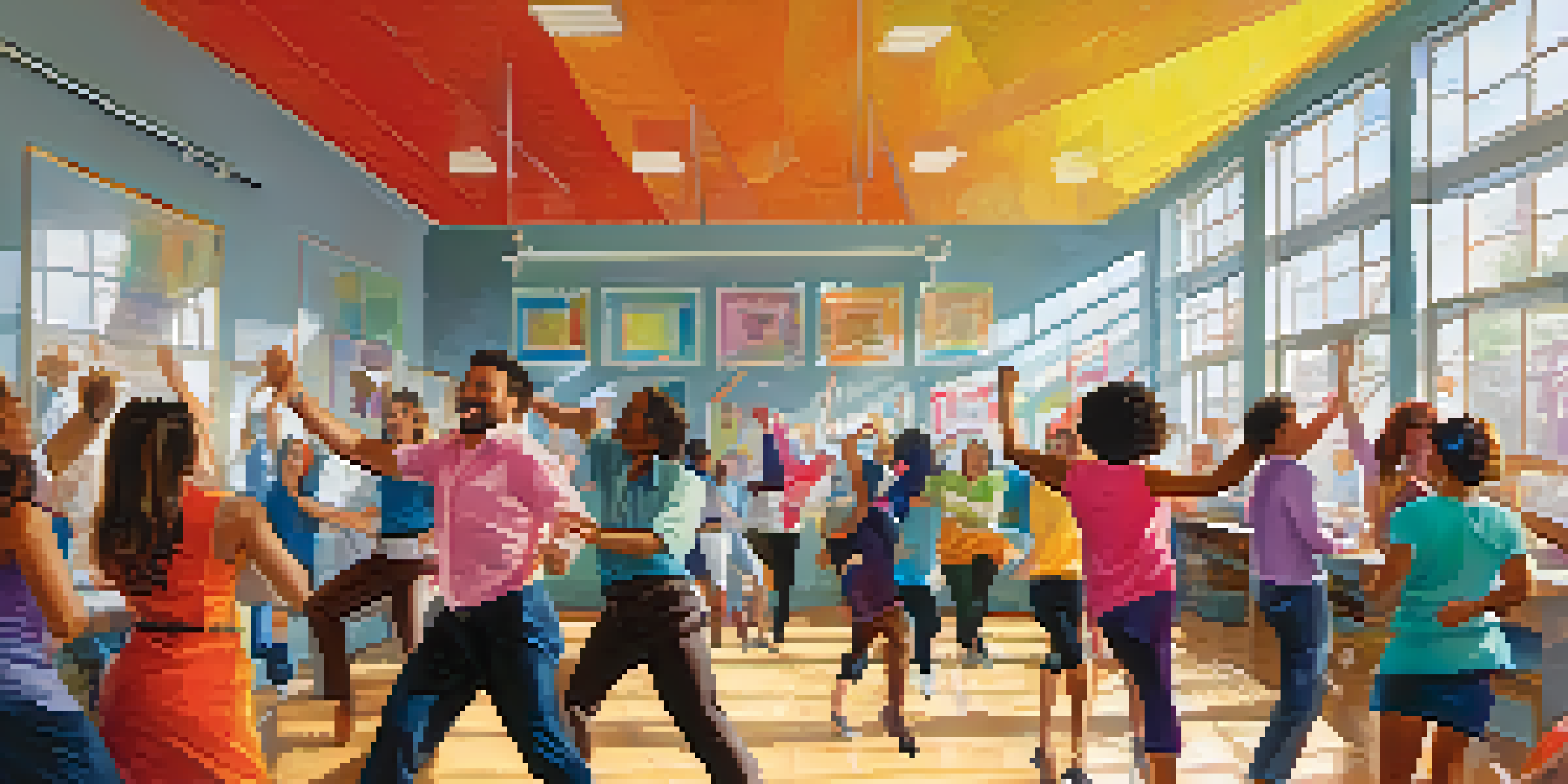The Role of Dance in Reducing Workplace Stress Levels

Understanding Workplace Stress and Its Impact
Workplace stress is a common issue that affects employees' health and productivity. Factors like tight deadlines, long hours, and interpersonal conflicts can create a high-pressure environment. Over time, this chronic stress can lead to burnout, anxiety, and even physical health problems.
Dancing is like dreaming with your feet.
Recognizing the signs of stress is crucial for both employees and employers. Symptoms can range from fatigue and irritability to decreased job performance. By addressing stress early, organizations can foster a more supportive and productive workplace culture.
In recent years, companies have begun to explore creative solutions to combat workplace stress. One such solution gaining traction is incorporating dance into the work routine, which has shown promising results in improving employee well-being.
Dance as a Creative Outlet for Stress Relief
Dance offers a unique form of expression that allows individuals to release pent-up emotions and energy. Unlike other forms of exercise, dance encourages creativity, making it a fun way to alleviate stress. Whether it’s a quick dance break or a structured class, moving to the rhythm can shift one’s mood significantly.

Many people find that dancing helps them forget their problems, even if just for a moment. This mental break can provide the clarity needed to tackle workplace challenges more effectively. Plus, the endorphins released during physical activity can lead to a natural high, further enhancing mood.
Workplace Stress Impacts Well-being
Chronic workplace stress can lead to burnout and health issues, making it essential for organizations to address it early.
Additionally, dance promotes a sense of community among employees. Engaging in group dance activities can strengthen relationships and foster teamwork, which is essential in reducing feelings of isolation and stress in the workplace.
The Physical Benefits of Dance for Stress Reduction
Engaging in dance not only lifts your spirits but also provides significant physical benefits. Regular movement helps improve circulation, boosts energy levels, and reduces muscle tension—all of which contribute to lowering stress. The act of dancing can be a full-body workout, allowing for an effective outlet for physical stress.
Dance is the hidden language of the soul.
Moreover, dance enhances flexibility and strength, which can lead to improved posture and reduced discomfort associated with sitting for long periods. This physical improvement can naturally lead to a greater sense of well-being and less stress, particularly for those in sedentary jobs.
With the right dance routine, individuals can also develop better breathing techniques. Deep, controlled breathing while dancing can calm the nervous system, helping to manage stress levels more effectively both in and out of the office.
How Dance Classes Can Fit into Work Schedules
Incorporating dance into the workplace doesn't have to be complicated. Employers can organize weekly dance classes during lunch breaks or after work hours, making it easy for employees to participate. This flexible approach allows everyone to join in, regardless of their schedules.
Companies could also consider setting up informal dance sessions or flash mobs as a way to break the ice and encourage team bonding. These spontaneous events can lift spirits and create a positive atmosphere in the workplace.
Dance Enhances Mood and Community
Incorporating dance into the work environment not only alleviates stress but also fosters teamwork and strengthens employee relationships.
With the rise of virtual platforms, online dance classes can also be a viable solution for remote teams. Employees can join from the comfort of their homes, ensuring that everyone has access to this fun stress-relief method, regardless of their location.
The Role of Music in Enhancing Dance Experience
Music plays a crucial role in the dance experience, acting as a catalyst for emotional release. The right playlist can set the mood and energize participants, making them more likely to engage fully in the activity. Dancing to favorite tunes can evoke positive memories and feelings, further enhancing stress relief.
Moreover, the rhythm and beat of music often encourage movement and can make dancing feel more natural and enjoyable. This connection between music and dance amplifies the overall experience, allowing individuals to lose themselves in the moment.
Creating a communal playlist where employees can suggest songs can also foster a sense of ownership and connection among team members. This small act can enhance camaraderie, making the dance experience even more enjoyable and effective in reducing workplace stress.
Case Studies: Successful Implementations of Dance Programs
Several companies have successfully integrated dance into their wellness programs, showing impressive results. For instance, a tech firm introduced weekly dance classes, leading to a 30% decrease in reported stress levels among employees. Participants noted increased job satisfaction and a more positive work environment.
Another example is an advertising agency that organized monthly dance-offs, which not only provided stress relief but also sparked creativity among teams. Employees felt more inspired to share ideas and collaborate after engaging in these fun activities.
Flexible Dance Classes Boost Engagement
Offering flexible dance classes, whether in-person or online, can fit easily into employees' schedules, promoting participation and stress relief.
These case studies illustrate the tangible benefits of incorporating dance into workplace culture. As more organizations recognize the value of creative outlets like dance, we can expect to see a shift towards healthier, happier work environments.
Encouraging a Dance-Friendly Workplace Culture
Creating a dance-friendly culture starts with leadership support. When managers and executives participate in dance activities, it sets a positive example for employees. This top-down approach can help normalize dance as a legitimate form of stress relief.
Incorporating dance into company events, such as team-building exercises or celebrations, can also promote a dance-friendly atmosphere. These events provide opportunities for everyone to join in, regardless of their skill level, fostering inclusivity and fun.

Ultimately, encouraging a culture that embraces dance can lead to a more engaged and cohesive workforce. As employees feel more connected and supported, they are likely to experience lower stress levels and improved overall well-being.